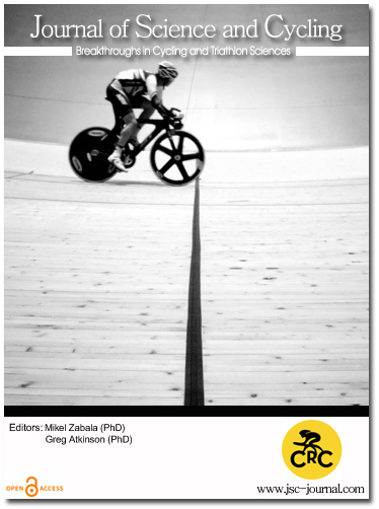Caffeine supplementation improves simulated 16 km cycling time-trial performance without altering pacing strategy
Keywords:
Caffeine supplementation, cycling time-trial, pacing strategy, mean power output.Abstract
Background: Caffeine is a well-known ergogenic aid with a high prevalence of use by endurance athletes including cyclists and tri-athletes (Del Coso et al., 2011). Acute caffeine supplementation has been shown to improve cycling time-trial (TT) performance of short duration, namely 1 (Wiles et al., 2006), 4 (Santos et al., 2013) and 10 km (Astorino et al., 2012). Santos et al. (2013) were the only study to show an altered pacing strategy with caffeine during a 4 km TT. It is currently unclear, however, whether caffeine improves TT performance of longer duration and whether this is due to changes in pacing strategy. Therefore, the aim of this study was to investigate the effect of caffeine supplementation on pacing during a simulated 16 km cycling TT performance.
Methods: Forty-two well-trained competitive cyclists (mean ± SD; age 37 ± 8 y, body mass 74.3 ± 8.4 kg, height 1.76 ± 0.06 m, maximum oxygen uptake 50.0 ± 6.8 mmol·kg-1·min-1, maximal power output 329.7 ± 53.8 W) performed a simulated 16 km TT on three occasions; 1 h following either 6 mg·kg-1BM caffeine (CAF) and placebo (PLA) supplementation and one control (CON) session without supplementation. Mean power output (MPO) was recorded following completion of 25, 50, 75, 90 and 100% of the test. Blood lactate was measured at rest, following 25, 50, 75, 90 and 100% of the test, and 5-min post-exercise. Data were analysed using mixed-model analyses and magnitude based inferences.
Results: There was an overall effect of supplement on MPO (P = 0.0002) with post hoc analyses revealing an improved performance in CAF versus PLA (+3.0 ± 5.8%, 234.2 ± 36.7 vs. 228.0 ± 37.6 W, P = 0.007; 87% likely beneficial) and versus CON (+4.1 ± 6.2%, 234.2 ± 36.7 vs. 225.7 ± 38.4 W, P = 0.0002; 99% very likely beneficial), and no difference between PLA and CON (P = 0.50; 20% unlikely beneficial, Figure 1). There was a significant effect of time (P = 0.02) and trial (P ≤ 0.001) on pacing, with higher values shown in CAF vs. both PLA and CON (P ≤ 0.001), although these did not reach statistical significance at any specific time point throughout the test (time x trial, P = 0.93, Figure 2).
Discussion: The current results suggest that caffeine supplementation can improve simulated 16 km TT performance through an increased overall MPO though not via a modified pacing strategy throughout the exercise. Although no statistical differences were shown at any time point between trials, routine analyses may not have been sensitive enough to detect small but potentially worthwhile differences. Indeed, upon inspection of average powers throughout the test, with the exception of the final 10%, caffeine supplementation appeared to result in an increased MPO at every time point. Thus, it could be concluded that the cumulative improvement at every time point led to the overall improvement with caffeine.
Conclusions: Caffeine supplementation improved simulated 16 km TT performance via an increased overall MPO throughout the test, without modifying pacing strategy. These data suggest cyclists can expect to experience moderate but potentially worthwhile gains in performance with caffeine during TTs of short duration (<20 km).
Downloads
Published
How to Cite
Issue
Section
Copyright (c) 2016 Journal of Science and Cycling

This work is licensed under a Creative Commons Attribution-NonCommercial 4.0 International License.
Authors contributing to Journal of Science and Cycling agree to publish their articles under a Creative Commons CC BY-NC-ND license, allowing third parties to copy and redistribute the material in any medium or format, and to remix, transform, and build upon the material, for any purpose, even commercially, under the condition that appropriate credit is given, that a link to the license is provided, and that you indicate if changes were made. You may do so in any reasonable manner, but not in any way that suggests the licensor endorses you or your use.
Authors retain copyright of their work, with first publication rights granted to Cycling Research Center.






